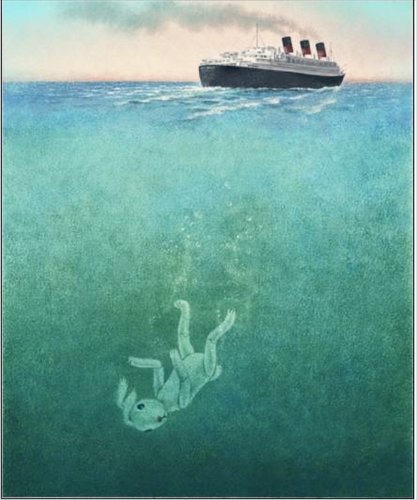Inspired reading
The incredible popularity of South Korean TV drama series, You Who Came From The Stars, and particularly its lead actor, Kim Soo-hyun, has been criticized by many for turning hordes of its female viewers into hormone-driven obsessives.
However, while the social benefits of binge-watching the hit sci-fi comedy drama may be hard to see, reportedly the highbrow literary tastes of Kim's character are rubbing off on his fans.

An illustration from the book The Miraculous Journey of Edward Tulane
Kim plays an alien, Do Min-joon who has been living on Earth for 400 years disguised as a human, and who is currently working as a university professor - leading fans to refer to him as "the professor."
His popularity is down to him acting like an ideal man as he woos his love interest in the TV series (played by Jun Ji-hyun).
Such is his followers' fixation with him that it reportedly takes only the mention of a book by the professor for the title to start flying off shelves, as avid fans rush to get a deeper understanding of the character through his favorite works of literature.
Here we take a look at three of the titles that have seen sales shoot up since the show started its run in December. They are The Cloud Dream of the Nine, a 17th century novel written by a Korean writer, Kim Man-jung; Mingxin Baojian, a 14th century ancient Chinese book consisting of many aphorisms and quotations from other Chinese classics and works; and The Miraculous Journey of Edward Tulane, a children's book written by American author Kate DiCamillo.

The cover of the Chinese edition of The Miraculous Journey of Edward Tulane
The Cloud Dream of the Nine
Working in the Shanghai Classics Publishing House (SCPH), Min Jie recently finished editing a new edition of The Cloud Dream of the Nine, which was published by SCPH earlier this month.
The book was written in the 17th century, although some think it was originally composed in classical Chinese and then translated into Korean. The story is set during the Tang Dynasty (618-907). It tells of a young Buddhist monk's travels through other lifetimes, including one in which he is a wealthy man who meets eight beautiful maidens, each of whom he falls in love with. The monk eventually recovers his original identity and retreats into deep meditation, while the women become Buddhist nuns.

An illustration from the book The Cloud Dream of the Nine
Min told the Global Times that while she is not a fan of You Who Came From The Stars, she is glad to hear that Professor Do holds the book in such high esteem, regarding it as a guide for his life.
"The core ideas of this book are closely related to Buddhism and Confucianism, which were admired a lot during the Tang Dynasty," Min said. "Chinese culture was a big influence on surrounding countries at that time."
A version of the book in modern Chinese was printed in 2010 by Fudan University Press, while this later edition reverts to the original classical Chinese.
Min said the writers of the TV show seem to have been influenced by The Cloud Dream of the Nine, with both involving time-travel stories, and lead characters finding themselves among new cultures.
However, Min was skeptical regarding how long the boost of interest in classical Chinese literature provided by the TV show would last. "I'm actually not very convinced that the increase in public attention and interest in classical Chinese will be sustained just because of a TV drama," Min said.

An illustration from the book The Cloud Dream of the Nine
Mingxin Baojian
Hua Yi Publishing House based in Beijing originally printed Mingxin Baojian early in 2007, and recently finished a reprint run of 10,000 copies.
Mei Yu, the director of the editing department, told the Global Times the reprint was done because of the high demand from booksellers following the TV show.
In the TV drama, Professor Do recommends the book to his love interest, and even quotes some of the aphorisms that can be found in the text.
According to Mei, Mingxin Baojian was one of the most influential ancient Chinese books overseas and was the first book translated from Chinese into a Western language.
While Mei refused to disclose the exact number of copies the book has sold, he said current monthly sales exceed what the title would previously expect to see in a whole year.

An illustration from the book The Miraculous Journey of Edward Tulane
The Miraculous Journey of Edward Tulane
The Xin Lei Publishing House based in Tianjin has imported and published the Chinese version of The Miraculous Journey of Edward Tulane since 2007. The book tells the tale of a rabbit made of porcelain. He is originally owned by a little girl, but lost during a boat trip. He is subsequently found, and passed through a string of owners around the world.
Liu Changhong, director of Xin Lei's marketing department, told the Global Times that the book received unprecedented attention recently, and that many Chinese authors of children's books also hold the work in high esteem.
Liu said a quote from the book sums up its message, which she says is similar to that of the TV show: "If you have no intention of loving or being loved, then the whole journey is pointless."

The cover of The Cloud Dream of the Nine Photos: Courtesy of the publishing houses